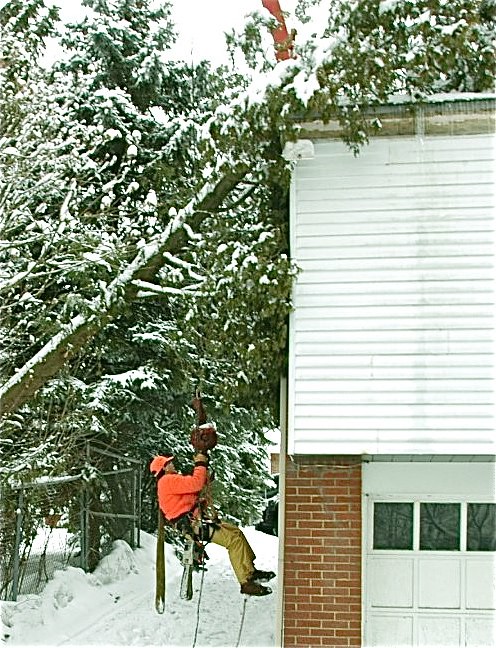TreEmergencyB
ArboristSite Guru
New company uses a crane often only problem is the climber just throws his lifeline and lanyard over the hook and off he goes. Now i know thats not how its supposed to be done so im looking for a pic of a better way.


Ok....well.....here is what I believe to be the approved and safest way......
Use a small shackle and slide it through the loop end on a single loop friction saver that is long enough to hang to the bottom of the ball. You then tie into the ring on the friction saver. The set up is mounted, as I said, above the ball..... So that way you have double safety, as you are attached to the cable, just like the ball is.
Here is a link with the standard as well as a few pictures: PDF format:
www.#############/pdf/mar07-cb.pdf
Ok....well.....here is what I believe to be the approved and safest way......
Use a small shackle and slide it through the loop end on a single loop friction saver that is long enough to hang to the bottom of the ball. You then tie into the ring on the friction saver. The set up is mounted, as I said, above the ball..... So that way you have double safety, as you are attached to the cable, just like the ball is.
Here is a link with the standard as well as a few pictures: PDF format:
www.#############/pdf/mar07-cb.pdf







Yup, your climb line over the ball and your lanyard on the hook.
Jeff
Friction saver and locking shackle above the ball, never in the hook with slings and chain. Keep your climbing line seperate and protected from eveything abrasive, anything that can pinch or bind it, and off the hook.
Friction saver and locking shackle above the ball, never in the hook with slings and chain. Keep your climbing line seperate and protected from eveything abrasive, anything that can pinch or bind it, and off the hook.
New company uses a crane often only problem is the climber just throws his lifeline and lanyard over the hook and off he goes. Now i know thats not how its supposed to be done so im looking for a pic of a better way.
This is a much safer way to attach then using a friction saver
I don't know jack about crane work really, but that looks like something I could work with!
I assume you had to dismantle the ball (or whatever it's called) to get that link in there? Nice.
This is a much safer way to attach then using a friction saver

Much safer? I don't think so. As depicted in Pete's image, the friction saver provides the same level of protection as using it in a tree. Keeping the rope off the ball "thingy" is the goal and both methods depicted accomplish that.
Me Culpa on using a steel 'biner on the cable above the ball in my example, as my rope still ran across the ball which should be avoided.
"Wayne the Crane" didn't have the clevis i would have preferred to use, so I had to make do.
Here's a photo:


[
QUOTE=Aerial Arborist;2875511]For starters an aluminum friction saver has no place anywhere near the almost 300lb ball.
The picture that was posted was off an all aluminum set up, norm from the" other site" posted that a while ago.Steel rings on the friction save and steel biner on the shackle captures the FS. As you know steel and aluminum don't play well together.
Looks good to me! This is the only way that I know of that is ANSI approved...
Enter your email address to join: